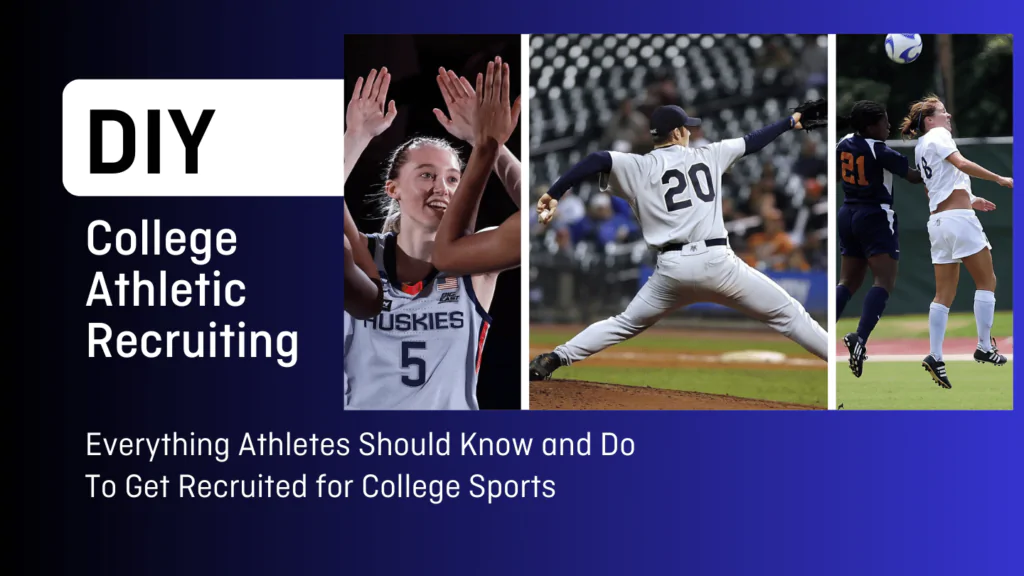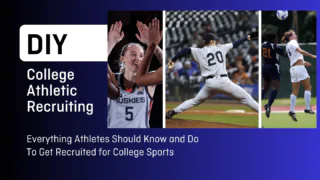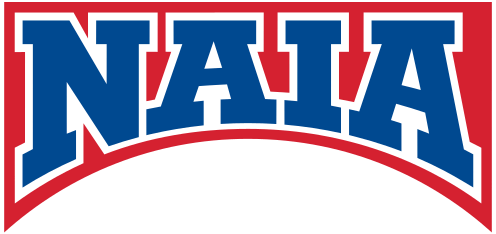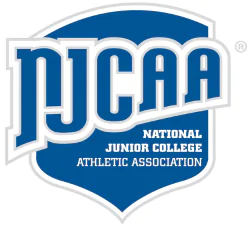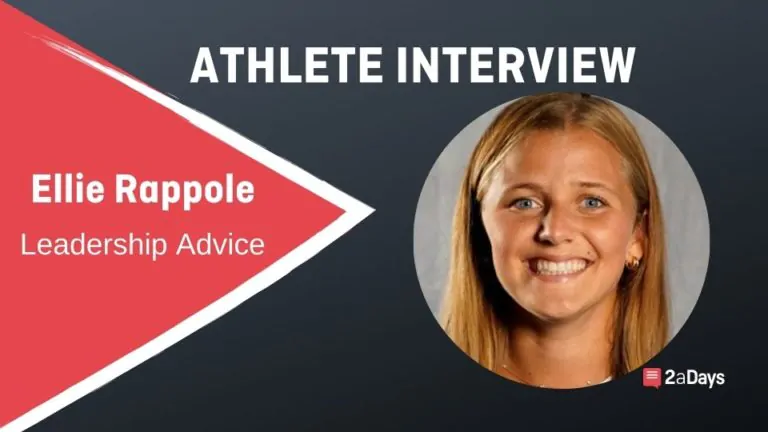Whether you're the parent of an athlete or the talented athlete yourself, making the decision to play college sports is both exciting and scary. There are a lot of rules, practices, and unknown etiquette that can scare kids and their families off, or worse, get them in trouble before even starting the sports recruiting process.
Don't let the recruiting process overwhelm you, and certainly don't wait to take initiative. This DIY college sports recruiting guide will give your family everything you need to know when it comes to the recruiting process. This sports recruiting guide will serve as a checklist to ensure you have your ducks in a row.
Let's not wait a second more. These actionable steps will get you going on the right path starting today.
In This Guide
- When to Start Your Sports Recruiting Process
- Understanding Which Division/League to Target
- What Role Do Your Parents/Family/Friends Play
- Sports Recruiting for Different Seasons
- How To Gain Exposure
- Understand What College Coaches Are Looking For
- Contacting the Head Coach
- Is the Coach Really Interested in You?
- The College Coach Whiteboard and Timeline
- What “Band” Are You In
- Understanding Athletic Scholarships
- What You Need to Know About Campus Visits
- How to Find the Right Fit
- What To Know Before Applying
- The Application Process
- Congrats! You Are A College Athlete: Now Manage Your Expectations
- A Final Word
When to Start Your Sports Recruiting Process
It's never too early or too late to start taking action when it comes to the sports recruiting process. Athletes naturally take initiative, and the mindset to approach recruiting should be no different.
There are two ways to look at starting the college sports recruiting process:
- It's never too early. Most athletes will start their sports recruiting process around freshman year of high school. Some start even earlier. Having said that, keep in mind certain restrictions are in place to prevent young athletes from engaging with coaches too early.
- Already past freshman year? No problem! While it's always good to start as early as possible, some athletes get recruited all the way up until their senior year! If you feel you do need more time, there are many reasons to take a gap year as well.
Understanding Which Division/League to Target
Many athletes have heard of the NCAA's three divisions: DI, DII, and DIII. But, some athletes are surprised to hear there are other collegiate sports leagues and organizations that have a different set of rules than the NCAA.
Other leagues include, but are not limited to:
- NAIA
- USCAA
- NCCAA
- ACCA
- JuCo
Understanding the differences between the three divisions of the NCAA as well as the different collegiate sports models and leagues is important. This requires having an open mind, which can be the first obstacle for many athletes who are set on the “DI label.”
Keep an Open Mind: Why You Don't Want a DI or Bust Mentality
We see Division I sports on TV all the time, and they look glamorous. The fireworks, the cheerleaders, the cool uniforms. It all looks great. What you see is not always what you get. This sentence alone should be at the forefront of your mind when you start pursuing colleges.
There are great aspects and accomplishments to playing at the DI level, but there is also a benefit to considering other divisions and leagues. For starters, if your goals align slightly more with education than they do with athletics, then it's good to know that some of the best academic schools that are on par with the Ivy Leagues are Division III.
There's also the popular New England Conference, NESCAC, which is both an athletically and academically competitive conference where many athletes have the ability to play at the DI level while pursuing an exceptional education.
Let's take a look at the stats and percentages of athletes that play in the NCAA:
- With roughly 346 colleges and universities at the Division I level, only about 2% of high school athletes are awarded athletic scholarships.
- Roughly 1 in 57 or (7%) of athletes go on to play Division I from high school.
- At the Division II level, 14% of the student body plays on varsity teams. This is more than double Division I (6%).
- At the Division III level, the percentage of the student body that plays on varsity teams rises to 21%. This more than triples Division I.
Don't let the statistics discourage you. Division I is certainly achievable. The reason Division I should not, however, be your only goal.
There are many different opportunities offered at the Division II and III levels as well as in other leagues. This could be better academic incentives, playing under different rules, or simply how the college campus operates. When being recruited, you should look at what each school you are interested in has to offer and compare them. This allows you to focus on more than just athletics.
Understand the Real Difference Between the Divisions and Leagues
Within the NCAA, we have three different divisions, which all offer different opportunities and levels of athletics and academics. In addition to the NCAA, there is also the NAIA and JuCo, which are two separate sports entities that operate under a different set of rules while still offering an education, scholarships, and more. To really know which level to target, you need to understand the general differences between these options, then further investigate the schools within them.
The process can be long, but doing your homework will work out better in the long run than leaving it to chance when it comes to researching schools.
NCAA Divisions: DI, DII, and DIII

The National Collegiate Athletic Association is the most popular college athlete organization by member schools. It consists of three divisions that are meant to represent the level of competitiveness. Having said that, it doesn't always hold true that all DI schools are more competitive than all DII or DIII. Make sure you research each school's athletic record before you commit.
In general, here are your key differences:
- DI schools have the biggest athletic budgets, which they prioritize on facilities, scholarships, recruiting, and more. These schools will likely have the toughest schedules with games/matches and practice. The dedication to the sport at this level is very high with a split focus on academics, or in some cases, more focus on athletics. At this level, a low percentage (1%) go on to pursue professional sports, but it is the division most athletes who hope to go pro pursue. DI schools are usually the schools with the biggest student bodies and the most athletic scholarships awarded, with the exception of the Ivy League Conference, where athletic scholarships are prohibited.
- DII has fewer athletic scholarships than DI, but still has quite a few to offer. With smaller budgets than DI, DII schools compete more at the regional level than at the national level. Division II offers a competitive balance between sport intensity and academics.
- DIII is the largest division among the three, offering mainly academic scholarships for athletes. While there are many competitive DIII teams on par with some DI and DII teams, the focus on academics becomes significantly higher in this division. With no athletic scholarships offered, mandatory practice hours and game schedules are less intense than at Division II and III schools.
Related: 3 Great Options and 3 Ways to Decide: Which NCAA Division is Right For You?
NAIA
The National Association of Intercollegiate Athletics is another governing body that competes with the NCAA. While they are not as large of an organization as the NCAA, they do have quite a few benefits to offer athletes that the NCAA cannot. Like the NCAA, NAIA offers four-year schools but has significantly fewer students than the NCAA, totaling 60,000 athletes across their universities.
90% of NAIA has scholarship money available. One of the big reasons you may find some tennis, golf, or other teams stronger at the NAIA is because their funding may beat out some Division I schools that lack a revenue-building Football or Basketball team.
The NAIA also has different academic requirements than the NCAA.
Related: NCAA vs NAIA
JUCO
Junior Colleges can be a great step towards college athletics. This route has been gaining more popularity in the last few years. Some of the reasons athletes may choose to go to a JuCo before attending a four-year can be found below:
- It offers athletes a chance to get their grades up if they do not meet the academic standards for their school of choice at the time of application.
- It offers athletes a chance to refine their skills and get more playing time before entering a four-year college.
- It establishes a time dedicated to self-discovery and maturity before entering college, allowing athletes to become more confident.
- It gives more time for those who started the college sports recruiting process later than they wanted.
What Role Do Your Parents/Family/Friends Play
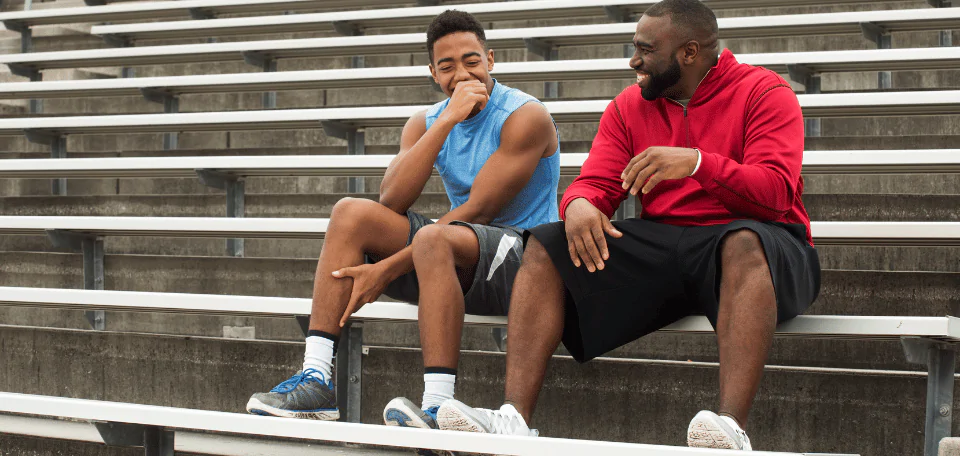
Your parents have likely been some of your biggest supporters throughout this entire journey. It's important to know that their role should be supportive, but not overbearing. When a parent hijacks the sports recruiting process, it can damage the athlete's ability to get recruited.
Why?
Because if the parents are too involved in the process, a coach may feel the athlete is not mature enough to handle their own business. They also may fear constant interference from the parents that won't allow the athlete to develop under the coach's guidance.
Here are some coaches' quotes that express the need for parents to remain supportive but not over-involved:
Coaches… look closely at how parents act as well and are doing a lot of research on the entire family before recruiting begins.
– UC Berkeley Women's Soccer Coach, Neil McGuire
Don't have your parents send a letter or email on your behalf.
– Michigan State University Baseball Coach, Jake Boss Jr.
On the other hand, parents should show some involvement. As mentioned, a coach may take the time to get to know the player off the field or court. Their family's background and values can be telling for a coach.
Parents must be involved to help their child process all the information and help their child make an informative decision. Many times handlers and coaches manipulate the recruit. Parents must educate themselves on the recruiting process. It has become a big business and there are a lot of wolves out there!
– University of Rhode Island Women's Basketball Coach, Tammi Reiss
For parents who are navigating this process with their child, it's worth reading about how this parent dealt with the pressures of the process:
It was hard to be ‘hands-on' with a process I was completely unfamiliar with. I tried to give as much advice and communicate as much as I could with my son to try and figure out what the best option for him was. Ultimately, I wanted the decision to be his. I always made myself available if he had questions or wanted advice. I tried not to force my opinions on him or make the decision for him.
– Parent, Laurel Jenkins
Related: 4 Tips for Parents of Recruits With College Potential
Sports Recruiting for Different Seasons

There are essentially three different seasons for collegiate athletes. You have fall, winter, and spring, which all recruit at different times. Something that also affects college sports recruiting timelines is the division you are aiming for and the year you are being recruited. Athletes who play spring sports can be offered much later than those who play fall sports.
Division III, NAIA, and junior colleges can start recruiting as early as sophomore year. While DII and DI can start recruiting junior year, no offer can be made until senior year.
There are also two different signing periods, one in the fall and one in the spring of senior year. This allows for open spots and mid-year recruits.
Keep these timelines in mind when contacting coaches, creating highlight videos, and visiting schools.
How To Gain Exposure
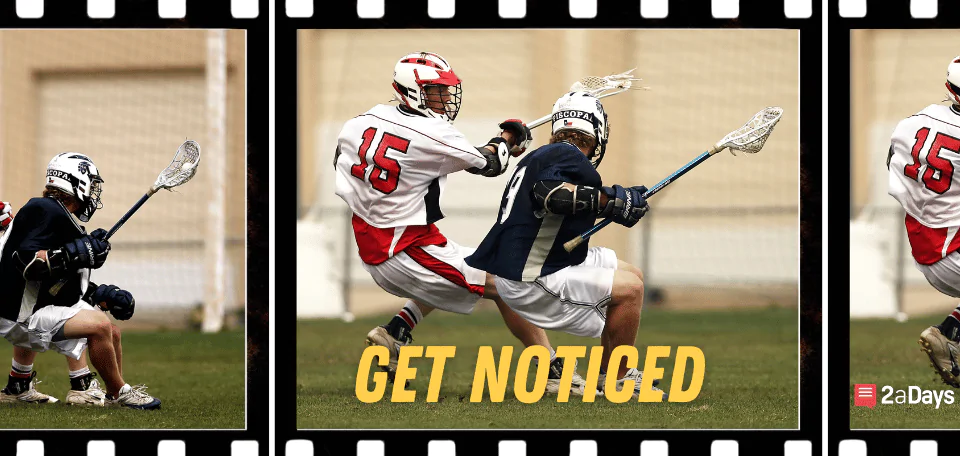
Now that you understand a little more about what the different levels are, it's time to think about how you can gain exposure to your target schools. Luckily, technology and social media have made highlighting your results and overall brand/portfolio a lot easier. That being said, there are still traditional methods like college camps, competitions, and more that you should participate in.
There is no substitute for coaches seeing you live in action, which is why we will emphasize that. Secondly, personality is one of the biggest aspects a college coach watches out for. That's why utilizing social media to demonstrate key team characteristics is vital.
Here are several key areas to gain exposure with specific instructions to better your chances of getting noticed:
Attend College Camps
Attending college camps is a great opportunity to gain exposure because it demonstrates all the important things a college coach needs to see. First, it shows the initiative that you want to connect with college coaches and their programs. Second, it allows you to demonstrate your skills in person, which can be very different from in a highlight video.
But what does it really mean when a college coach invites you to camp?
It's sometimes hard to tell whether you are being recruited or just getting a generic email. Look for personal information in the email that would separate you from someone else. It's a good sign if a coach also leaves their personal contact information.
Regardless of whether you are considered a camper or a recruit, there are a few tips and tricks you should have down before going to increase your chances of impressing the coaches.
- Remember the primary focus is showing your skills and demonstrating your ability and desire to improve/develop them further. Depending on where you're at in your junior career, the expectations may be a little different, but demonstrating the care for growth is important.
- Know the college coaches who are going to be there. Write a list of each coach/assistant/school and make sure you know their faces. Going the extra mile by taking an interest in their previous seasons or notable differences from one another is important.
- Find a way to stand out in the right way. Having a QR code that directs coaches to your list of academic and athletic accomplishments is a great way to showcase your abilities when the camp is over. This is one of many ways you can stand out.
Related: 4 Pros and Cons of Attending Showcases and Camps as a Recruit
Attend College Showcases
College showcases are different from college camps because they put the main focus on your ability to perform within your sport. While a lot of the same principles from above apply, you should think about emailing the coaches you have interest in beforehand to let them know you are coming. This will put your name on their radar from the beginning.
It's important to remember that it's OK if you don't do your best. Some coaches care more about how you react when you struggle than how you do when you win. This is because it shows character that will or will not fit within their team.
Create Highlight Videos
Creating highlight videos has never been easier. With social media and technology, creating a good highlight video doesn't have to take as long as it used to. Remember, a highlight video(s) linked on social media should stand out.
How do you do that?
- Create a portfolio on social media solely dedicated to your sport, providing updates on results and your training.
- Create a few different highlight reels that introduce who you are, what your goals are, and some of your best moments.
- Make individual videos for programs you are interested in. THIS SHOULD NOT be posted online. This is to email each program expressing your interest in their specific school and why. Then include your highlights! Bonus points if you mention some obstacles you've overcome and some long-term goals.
Related: Want to Wow Recruiters? Top 5 Platforms to Help You Create the Best Highlight Reel
Talking to Your Highschool/Junior Coaches
Whether you play for your high school team or you are a part of an academy, it's important to involve your current coaches in the process. They may have connections or be able to introduce you to programs they have previously worked with.
If you come from a good program, other players before you will likely have found their way to schools that may or may not be at your target level. Talking to your coach about your dreams and goals for attending specific colleges is not only a great way to gain exposure but also to make sure your team is on the same page.
Joining Teams
Not everyone's high school program is a great fit. This is why gaining exposure on elite club teams, joining academies, or participating in individual tournaments is a great way to control your exposure and work on your game. If you are considering playing a college sport, it is not unheard of for a high school athlete to transfer schools or programs to find a more suitable program for their level.
Look at what programs and academies players at your schools of interest played for. If it is possible to follow similar paths by joining the same programs, this will further help you gain exposure to specific universities.
In every sport for certain elite levels, there will be specific tournaments or showcases that college coaches are known to attend. These are events you want to be at to demonstrate how you fit in with their team.
Related: Recruiting FAQs: What's the Difference Between High School and Club Sports?
Understand What College Coaches Are Looking For
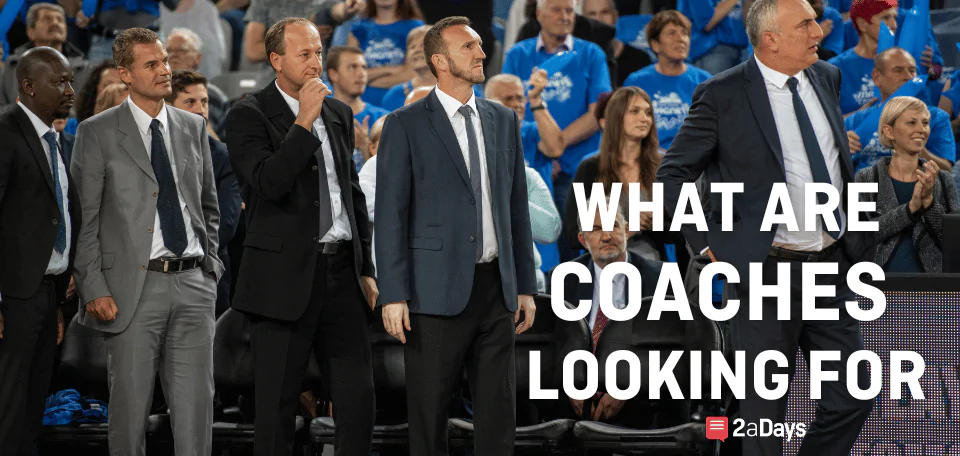
We have mentioned the important qualities a coach looks for to determine if you are a worthy member of their team. One of those qualities was showing interest in that particular school.
By expressing the following, a coach will know you have done your homework and are interested in the school itself:
- Talking about the team's highlights and past seasons
- Expressing interest in certain majors offered at the university
- Asking questions about the team dynamic and what works best for the team
Be personal. Know who you are contacting and why. Be prepared to discuss why our particular school is of interest to you.
– NC State Head Volleyball Coach, Linda Hampton-Keith
One question you ask should be about position openings on the team. This will indicate where you are on coaches' priority list. Knowing whether you are being recruited for a certain position or in general is also important. It is not unusual for an athlete to play a new position because the coach thinks it suits them best or because that's where they are needed. If the coach does want you for your position, but that position is not open, you may also have to be prepared to redshirt or not get much playing time when you first join the team. Understanding the role you will play early on and being willing to adapt to the coach's needs is important.
We also mentioned bringing character and personality to your game during these showcases or opportunities. Who you are when you win is important, but who you are when you lose is more important. This is why a lot of coaches bring up coachability. Are you willing to make the adjustments they ask for?
Talent, academics, and coachability, which includes body language.”
– Skidmore Men's Basketball Coach, Joe Burke
And, when we talk about putting your name out there through highlight reels, social media platforms, and emailing coaches, it is because you need to show the coaches you are invested in the process and care about going to that school! Right off the bat, if you play hard to get, a coach may assume you have poor team qualities.
Be the driver of your own recruiting experience. Reach out to the places you are interested in, give as much information as possible, and don't be shy about calling coaches. Again, I prioritize the student-athletes who are the ‘easiest to recruit,' meaning that I'm not pulling teeth to get them through the process.
– Princeton Heavyweight Rowing Coach, Gregory Hughes
Another thing to keep in mind is that coaches generally want the all-around team player with great skills, a good work ethic, and a fitting personality. Having said that, not all athletes are going to score straight A's in every category.
Related: Do You Have What it Takes? 5 Characteristics College Coaches Look for in Recruits
Some coaches are going to put an emphasis on results and your ability to get the job done. Other coaches are going to put emphasis on your coachability. Some coaches may care more about someone who can lead, while others care more about those who follow direction.
This is why it is important to get to know a coach and the types of players he or she already has on their team. It not only ensures you are a good fit for them, but it will help you decide whether they are a good fit for you.
A coach who prioritizes sports over academics will not fit well with an athlete who prioritizes academics over sports. This applies to every aspect of the athlete lifestyle, so make sure the school and coach you fit has priorities aligned with your own.
Contacting the Head Coach
Part of driving your own college sports recruiting experience is actually contacting the head coach. Regardless of whether you get an initial response or not, they will see your email and take note of who you are. Sometimes, if you aren't being actively recruited by the coach or the process is in the early stages, you may hear back from the assistant coach instead.
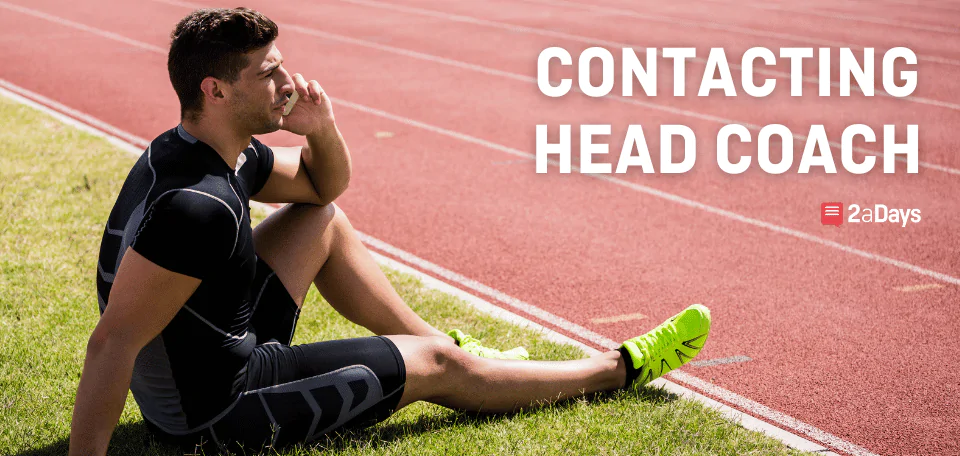
You can contact coaches at any time, but they may not be able to reply to you until junior or senior year, depending on the division. Don't let this discourage you! Even if they don't respond, reaching out to them at least gets your name on their radar.
If you have the right contact information, you can contact the coach via the following platforms:
- Email
- Make sure to include some identifying information about yourself, stats, a highlight reel, graduation year, and why you are interested in this program specifically; check out this template to get started
- Call
- Know what you're going to say ahead of time and be prepared to leave a voicemail – coaches are busy!
- Text
- This should be a paraphrased version of what you send in an email; texting is also an easy way to stay in touch with coaches after you've made initial contact
- Social Media
- Contact coaches with your professional account and their professional account; if you don't have a professional account, see our tips on keeping your social media clean so you know how to maintain a professional appearance
Many coaches agree that email is still one of the best ways to contact them because it is the most professional, easiest to attach resumes, and leaves a paper trail, among other benefits.
The best way would be through email, and that allows us to put them in a recruiting database to get information out to them about camps/clinics and give updates as the NCAA allows.
– Dartmouth Women's Soccer Coach, Ron Rainey
Related: Example Email to College Coaches
What Do You Say in an Email to Coaches?
You need to make sure you make a good first impression when you reach out to coaches. What you say is going to be important. You want to give enough information to express interest without overwhelming them.
An Email to Coaches Should Include
- Address the coach by writing, “Dear Coach (last name)”
- Introduce yourself
- Include your age and expected graduation year
- Tell where you are from and where you train
- Include years of experience
- Express interest in the particular school. Add a detail or two about their season or academics, but keep it short and sweet
- Highlight a major achievement you have had and link to your highlight reel, professional social media, or resume
- Thank them for their time
Do Not
- Don't have the email come from your parent's account
- Don't have your parent write the email for you
- Don't copy and paste the same email to every coach – coaches talk!
- Don't use any unprofessional or inappropriate words or phrases
Important Questions to Ask
Once you start correspondence with a coach, it's important to ask questions that cannot be answered through research. Make sure whatever questions you are asking cannot be easily found online.
These questions are worth asking once you develop a relationship with the coach:
- What do you expect from your athletes in terms of performance and overall character?
- What does a typical day look like for your athletes?
- How do the athletic schedule and academic schedule work together?
- What resources academically and athletically will be available to me?
- Where do I fit in on this team?
- What work do I need to do to start?
These are all difficult but important questions to ask a coach to get a better sense of how the team is run.
When to Bring Up Certain Topics
Some questions are more generic than others. Questions like where you fit in on the team and what you need to do to fit in are more personal and require a level of understanding between the coach and the recruit.
Because there is no official rulebook, it is important to remember some coaches may expect different types of questions. Based on the conversations you are having, you will need to judge the best time to ask certain questions.
The very first time you introduce yourself to a coach is probably not the best time to ask about the playing lineup. You can, however, ask what a coach would suggest you do to improve for the upcoming season.
Related: 5 Key Guidelines for Emailing Coaches During the Recruiting Process
How Often to Talk to a Coach
In the beginning, a coach may only be checking in with you every once in a while. But, as the sports recruiting season starts to pick-up, you can expect the coaches you have relationships with to check in with you more often.
Coaches that have expressed you are a recruit to them will likely leave you their personal contact information so they can answer questions for you as they come up. As the opportunity for official visits comes into play, coaches will start reaching out more and expect you to do the same.
After an official visit, it is important to reach out to that coach not long after to thank them and express your thoughts on the entire visit.
No Response? What Next
Don't stress if you aren't getting a response from a coach, especially if you are not yet a junior. This is because of the restrictions in place that don't allow a coach to communicate with you. If you don't get an initial response once you have hit junior year, it is a good idea to follow up with them again.
Coaches get flooded with emails from prospects that are interested in their school. There is a good chance they missed it. Following-up also shows extra initiative. The one thing you don't want to do is flood their email with updates every week. Give them a chance to consider your email and respond thoughtfully.
Related: Second Impressions Matter in Recruiting! 7 Tips For Writing an Effective Follow-Up Email to a Coach
If enough time goes by where a coach has not responded to 5-7 forms of communication and it is within the NCAA timeline for them to respond to you, they might not be interested in you as a recruit. Here are some tips from coaches on what to do if you get turned down by your dream school.
Is the Coach Really Interested in You?
There is no fool-proof answer when it comes to figuring out if a college coach is interested in you because they all express interest in different ways. This is why it's so important to stay in touch with your back-up options in case your first falls through.
Here are some indicators that a coach is actually interested in you joining their team:
- They respond to you often and in a timely manner
- They put a great effort into selling the school and why you would be a good fit for them
- They directly tell you that you are the number one recruit (be careful: this is not always the truth)
- They ask how you feel about the school and what questions you have
- They express interest in your family/personal interests outside of the sport
- They come to visit you specifically during your major competitions
- They give you personal contact information
- They invite you for official visits
These are just a few examples of when a coach genuinely is interested in you. It doesn't mean that offers won't fall through, but these simple signs are a good indicator of a coach's level of interest.
Opportunity: If you have extensive knowledge of soccer and are passionate about making a significant impact in the world of sports, explore the current openings for soccer coach vacancies
The College Coach Whiteboard and Timeline
We like to think of college sports recruiting as a dance that goes on between the recruit and the coach. This is because coaches are trying to ensure that all their spots are filled with the best possible options. The same can be said for the athlete. They are looking at their options for schools and will want to go to their very best option.
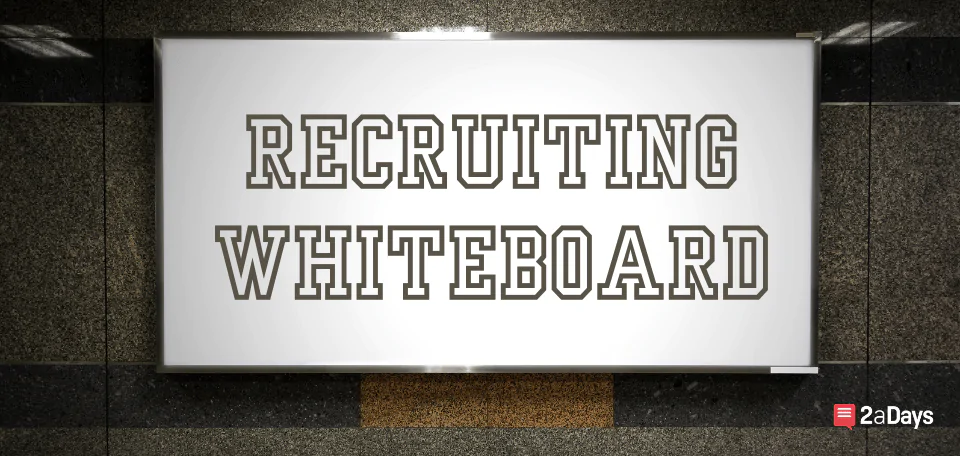
Understanding the cues of the dance is important for your own security. If a coach starts being a little less chatty, it's potentially because you have moved lower on their totem pole.
Related: College Coach Recruiting Boards: What Are They and Why Are They Important?
College coaches often use a “recruiting whiteboard.” This is how they organize every recruit on their team based on recruiting priority. Where you are on the whiteboard is directly related to how actively coaches will recruit you, but your position on the board isn't set. This is why it's important to be aware of when coaches rearrange names on the board, and to not let your guard down just because you seem to be high on their priority list.
Use this guide to understand the college coaches' whiteboard and how they manage their recruits and offers.
What “Band” Are You In
Understanding what priority level you are to a coach is important. This is commonly referred to as understanding what “band” you are in. Depending on the sport you play, a coach will be allowed a certain allotment of athletes in different bands. An athlete will be categorized into Band A, B, C, or D.
Band A athletes can get in on their own academically, whereas Band D athletes are going to be the most high-risk athletes and will need extra assistance. Typically speaking, there are far fewer spots in Band D than there are A.
So what happens here is that if there are only 2 spots for Band D, those spots take 4 out of 8 Equivalency Scholarships. In this way, 4 spots for those scholarships are gone, but only half as many athletes are recruited. It's important to know what Band you are in because it can significantly impact the chances of you getting on the team or not.
Related: 3 Signs a Coach is Losing Interest During the Recruiting Process
Understanding Athletic Scholarships
The big question is, what does an athletic scholarship entail? An athletic scholarship is financial aid awarded to an individual either in partial or full tuition, based on their athletic abilities. The agreement is that an athlete will receive this aid in exchange for competing for that school under contract.

Because there are different divisions/leagues, there are different types and availability of scholarships.
HeadCount Vs Equivalency.
Title IX ensures that there are the same amount of athletic scholarships and money awarded to female sports as there are male sports. Because of this, we get headcount and equivalency scholarships.
Headcount: These scholarships are include full tuition and cover the costs of room and board, food, and education. Headcount sports can only offer full scholarships and are restricted to the number of scholarships they can award.
Equivalency: There is no limit to the number of athletes on equivalency scholarships, but there is still a limit on scholarship money awarded. So, 20 athletes can divide up 10 scholarships, or a coach may give 5 athletes full and 15 partial scholarships.
No Athletic Scholarships Available
Not all athletes are offered athletic scholarships. A school with a lot of academic praise or focus may allow athletic programs to recruit based on athletic achievement while offering academic aid because of a lack of athletic aid. Certain eligibility requirements need to be met.
Related: Recruiting FAQ's: What if I Don't Get an Athletic Scholarship Offer?
Sometimes, unlike schools who recruit heavily through athletics, a school offering academic aid may not be able to waive or overlook some academic results that would normally not pass the exception. This means meeting the standard SAT scores, etc.
It's also possible for high school athletes to receive grants from high schools, state funding, and other means to be assisted financially. Just because athletic scholarships aren't available doesn't mean there are no other resources to provide aid.
Different Leagues, Different Rules
The allotted number of scholarships for different divisions and leagues is different. Different sports have their own sets of rules for college recruiting as well as for scholarships.
For instance, consider this allotment of athletic scholarships just between the three divisions of the NCAA; this is the maximum amount of athletic scholarships given across that Division:
Division I – 74,243
Division II – 36,343
Division III – 0
Related: Why Don't Ivy League Schools Give Out Athletic Scholarships?
Now let's take a quick look at the other leagues that are allotted athletic scholarships:
Alongside this information, here are 3 things every athlete should know about athletic scholarships.
What You Need to Know About Campus Visits

Visiting the college campus is one of the most important things you can do. While some athletes only take official visits, it's crucial to understand there are three types of visits that every family needs to take advantage of. The more you can learn about the school in person, the more informed your final decision will be.
Official Visits
During an official visit, a school can pay for the athlete's expenses for a weekend, or 48 hours. During an official visit, a coach will arrange for the athlete to stay in town and experience the typical day of a college athlete at this school. The recruit will go to classes, eat with potential teammates, and experience a normal practice.
Related: The Dead Period: What Is It And How Can It Affect College Athletes?
Family members may come with you, but must cover their own expenses. Athletes are only allowed to take five official visits at the Division I level. There are no limits for other divisions.
Unofficial Visits
Unofficially, you can all do the same things mentioned above but on your own dime. This means you can stay as long as you want on campus but can't be catered to by the coach.
Day Trip
Day trips are unofficial visits except the recruit does not stay overnight. You may meet with the coach if eligibility allows and explore the campus with your family. You can arrange your own schedule or ask the coach to help you.
Share Your Experience: Rate Your Campus Visit
How to Find the Right Fit
When recruiting, college coaches are looking for the whole package: a good fit on and off the field. This means they are interested in your grades, your work ethic, and your ability to work in groups, among other things.
The exact same can be said for the athlete looking for the right school. The sports and athletic experience needs to be a great fit in terms of what the athlete needs and wants. What also needs to be a priority is the education and other opportunities that may matter to an athlete. Certain priorities for one athlete may be different from another, such as school size, location, how good the athletics programs are, majors offered, and more.
What is important when finding out whether a school is the right fit or not is to compare how much of your checklists they meet in comparison to other schools. Your checklist should have all your priorities and extras listed.
On the Field Checklist
- College coach rating
- Win-loss record
- Position depth (is your position needed?)
- How long a coach has been with a program
- Competition level
- Team size
- Position openings
- Team culture
- Time commitment
- Travel
- Game livestreams
- Facilities
- Field/Court
- Weightroom
- Recovery Rooms
- Academic Areas
- Extras
Related: 4 Things Recruits Should Look For in Their Dream School
Off the Field Checklist
- Location
- On and off-campus housing
- School size
- Division/League
- Cost
- In-state
- Out of state
- Majors
- Class size
- Graduation rates of athletes
Whether each game is live-streamed is not talked about often, but it's a huge factor, especially for athletes far from home. Your parents can't travel to every game, and if your school or league doesn't offer live-streams for each game, your parents may not be able to watch you play at all.
What To Know Before Applying
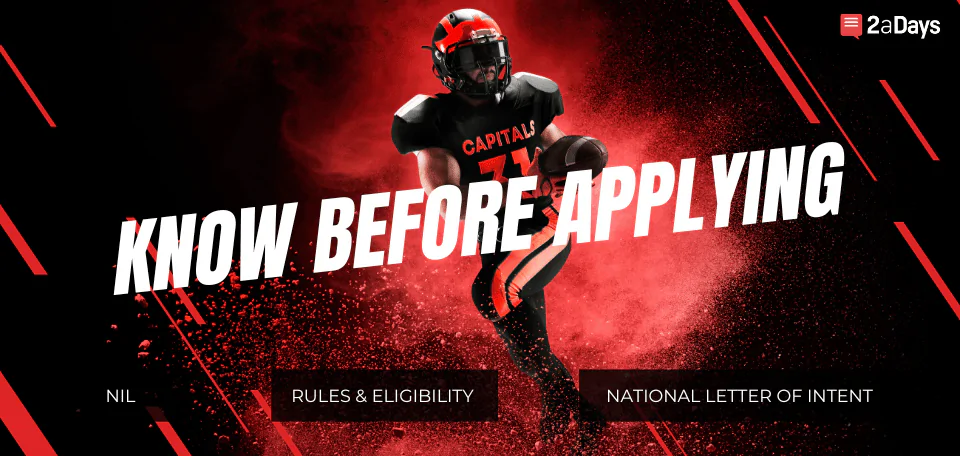
Before applying, it's a good idea to fully understand all the rules and details of the different divisions/leagues and academic expectations. While it can't hurt to officially read over the rulebooks, here are the main concepts you need to know:
Eligibility Center
The NCAA Eligibility Center determines whether an athlete is in good standing to compete at Division I or II levels. They have to meet academic requirements (graduation, SAT, TOEFL) as well as remain an amateur in the junior career.
NIL
Name, Image, and Likeness is a new policy put into effect July 1st, 2021. It allows student athletes to profit off their likeness, enter endorsement deals, and make money creatively through podcasts, social media channels, and more. It also grants them the ability to teach their sport. Each school, state, and the overall NCAA will have different regulations athletes need to adhere to.
Related: 47 Things All Recruits Should Check off Their Recruiting To-Do List
Division Rules
Depending on the division you want to compete for, you will need to understand that the recruiting rules, playing rules, academic rules, and others will change from division to division. When division rules are broken, athletes may face suspension or lose eligibility.
League Rules
The NCAA, NAIA, JuCo, and other leagues have different sets of rules and regulations that allow athletes to participate and obtain scholarships in their leagues. Each league will have a set of regulations available for athletes to follow.
College-Specific vs NCAA Rules
The NCAA has a hefty handbook of all the rules athletes and member schools have to follow. At the beginning of the year, compliance will go over these rules with athletes to ensure everyone is in good standing.
Additionally, schools have the ability to enforce their own academic and athletic standards and policies that comply with the NCAA but are specific to that school, so make sure you meet these requirements as well.
National Letter of Intent
A signed National Letter of Intent (NLI) is the contract signed between the athlete and the school. The NLI states that the athlete has committed to the school in exchange for whatever financial or athletic aid they have agreed upon. This contract binds the athlete to the school for the term specified, and requires the athlete to follow the league and school rules.
This signifies that an athlete will not be able to talk to other schools or be recruited by other schools while under contract with their current school. Should an athlete want to transfer or get out of their binding agreement, they will need to request a release from the coach and the school.
Related: Got NCAA Potential? Don't Miss These 5 Important Events In The Recruiting Process
Verbal Commitment
A verbal commitment to a school is your honor and word that you will play for that school under the agreement that has been offered by the school and coach. Unlike the NLI, it is a non-binding commitment that can be broken on either end.
This is more of an honor system that both athletes and coaches are expected to abide by.
The Application Process
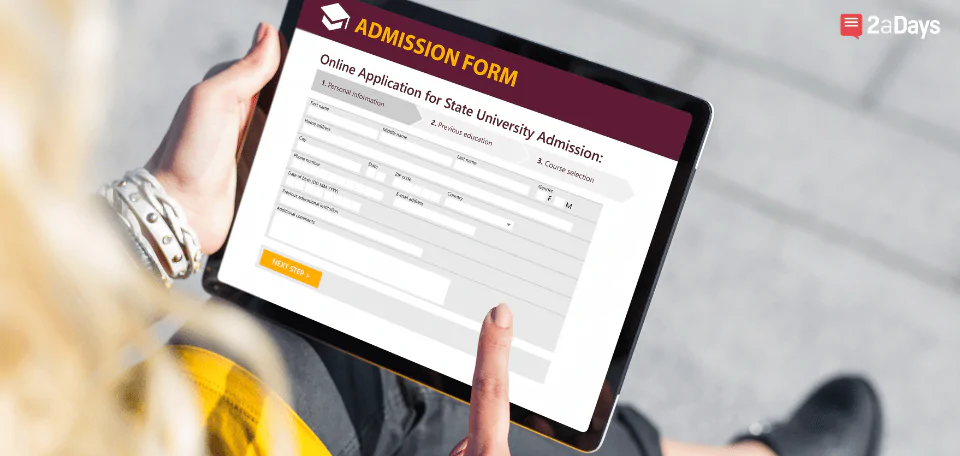
Now that you have reviewed the important steps in the college sports recruiting process, you are ready to apply. Through the application process, it is important to rely on family, guidance counselors, and coaches to help guide you as it can be both overwhelming and exciting.
Here are some of the important terminologies that need to be understood when dealing with application timelines:
Early Action
Early action simply means that a student may apply for a school early so that the school can let the student know their decision before the usual decision date. This allows a student to make an early commitment should he or she want to and eliminates some of the stress of waiting to hear back from their top choices.
Early Decision
Early decision is like early action, but if accepted, the student-athlete is committed to going there. When a student is accepted by their early decision school, they are committed to enrolling in that university and withdrawing their applications from all other universities. This is important to understand as an athlete because it affects your eligibility to be recruited by other schools. Many athletes don't make early decisions unless they are actively pursuing one school or possibly an Ivy League. Applying early decision shows your commitment to the coach and school, but you need to be certain this is the school you want to attend.
The important thing to understand with early decision is the student is restricted to doing this with one school, so reserve this for your top choice.
Related: How to Complete a College Application as a Recruited Athlete
Regular Decision
The regular decision follows the normal timeline in which a student will apply for a school. They then will hear back about their acceptance or denial at the same time as other students and commit to one of their accepted schools. This is the most common pathway for an athlete to take because it allows them to take their time when looking at their top choices.
Likely Letter
Academically speaking, a likely letter is a sign of hope for athletes. The likely letter is used by academic boards to notify top candidates that they will “likely” be receiving an acceptance letter in the future. While it is not a guarantee, it is an indicator that you are in the pool of top candidates to be accepted to that school.
Early Read
An early read is a process in which a coach will take the academic records of an athlete they are recruiting to the admissions board so that they make it a priority to assess their academic standing. This is used often for athletes who are being awarded scholarships so that can they can sign their NLI as soon as possible.
Congrats! You Are A College Athlete: Now Manage Your Expectations
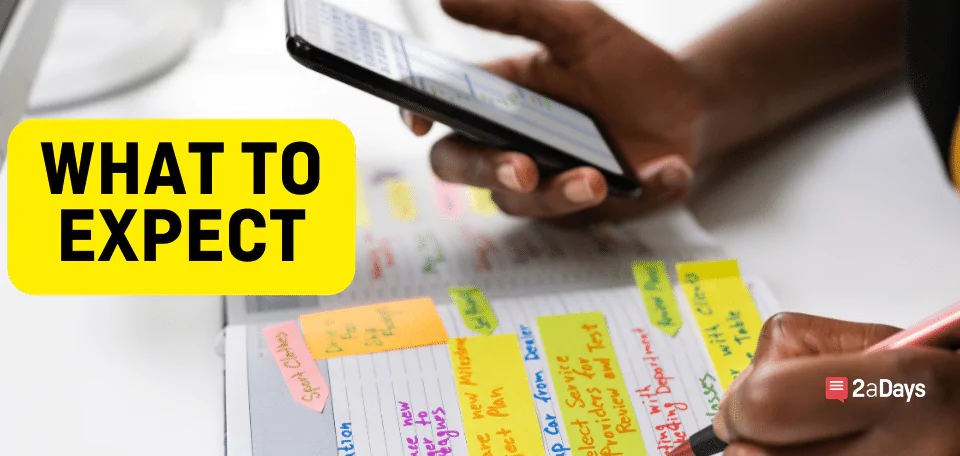
Phew! You made it! It is an exciting time when you have officially made it through the recruiting process and are being recognized for your talent and hard work as an athlete.
But, it is important to manage your expectations and know that there are still some challenges ahead. Adjusting to college is one thing. Adjusting to being a college athlete is a whole other thing.
Hours Spent on Sports Each Week
While different divisions and leagues have different rules, there is a limit on the number of hours a team can spend together practicing on the court as a whole. There are however a lot of ways around those hours.
The hours are capped to 20 hours a week or four hours a day. This is not always the case because of all the unaccounted time for fitness, conditioning, meetings, etc. This is something that you need to try your best to understand so you know what a coach expects beforehand because, for the highest levels of college competition, the hours can double from 20 to 40 a week.
Summers
Summer vacation is not always a vacation for athletes. You will be expected to do summer workouts individually or report back to campus early if you are in a fall sport. There are restrictions in place for athletes being able to work out, specifically with a coach during summers, but a coach will likely suggest that captains arrange “captains practices,” which have no limits.
Related: No Days Off: 6 Ways Athletes Can Train in the Off-Season
Off the Field Training
Off the field training doesn't necessarily count towards your practices. There is a huge time commitment that is dedicated just to fitness, strength training, and rehab. Because injuries are common in college sports, athletes spend quite a bit of time in rehab and recovery rooms. These hours do not count toward the 20-hour rule, but they are an important part of everyday life for the college athlete.
Academics
Your other most important commitments are going to be your academics. To compete as an athlete, you need to meet academic standings. This might mean mandatory study-hall hours every week or tutoring. Many coaches will enforce study hall hours for freshmen, where you need to meet a set number of hours each week dedicated to studying in a room monitored by officials.
Other requirements include the number of credits you have to take to remain a full-time student and honor your NLI. This is all worked out with your sports academic counselor who will also likely require meetings.
Related: Ask an Athlete: Three Common Questions About College Academics, Answered
A Final Word
If you feel like you just whizzed through this guide and are panicked about not retaining the information right away, don't be! There is a lot to cover when it comes to the college athletic recruiting process, and that's why starting the process as early as you can is always a good idea.
Starting early gives you a chance to review, practice, and learn as you go. While the general principles remain the same, each experience is going to be unique because coaches, universities, and their programs will all have something different to offer.
Sharing these experiences with friends, family, and your support team makes it work out that much better for you. And remember, enjoy! This is one of the most exciting times to celebrate your accomplishments and achievements as a junior athlete.
* Originally published on May 24, 2023, by Brittany Collens
